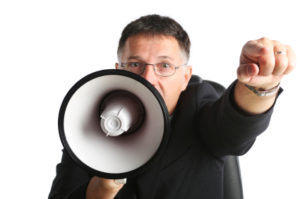How To Deliver A Closing "Call To Action"
Many public speakers are reluctant to offer an overt “call to action” at the end of their speeches. For whatever reason, many speakers feel uncomfortable telling the audience precisely what they want them to do after their speeches end.
I’ve heard people tell me that they don’t want to come across as an overly-aggressive salesperson, while others insist they don’t need to offer a call to action, since they’re confident that the audience will be able to infer what they should do next.
That’s a mistake.
Some estimates suggest that the average person is exposed to as many as 3,000 marketing messages per day. If you don’t tell people exactly what you want them to do, you can safely assume they won’t do it. So lose your self-consciousness about being overt. You can be assured that your competitors or opponents aren’t being shy about issuing calls to action, meaning you’ll lose if you insist upon subtlety.
Below are a few examples of calls to action. You might ask your audience to:
- · Sign a petition
- · Buy your product
- · Volunteer their time
- · Visit a website
- · Read a news article
- · Call their legislators
- · Visit their member of Congress
- · Vote for your preferred candidate
- · Support your position
Good calls to action are framed in the context of the audience’s needs, fears, hopes, and desires – not yours.
A bad (speaker-focused) call to action might be:
“We really need your help, or we may not be able to stop this project. Please help us by calling your state representative and telling him or her that you oppose it.”
A good (audience-focused) call to action might say:
“This new construction project will mean that our already crowded schools will get even more crowded, that our already congested roads will get even more congested, and that our already unreliable snow removal services will get even more unreliable. I know that many of you oppose this project, but merely feeling that way isn’t enough to change anything.
If you’ve ever been reluctant to get involved, this is the perfect moment to jump in. When you get home, please email your state representative. And tomorrow morning – before lunchtime – please call your representative to follow up. We have a handout of the names and numbers of all of your local representatives in the back of the room. You have the power to defeat this project – and I hope you will do your part to stop it.”
That call to action works better because it is specific (email tonight and call tomorrow), audience-focused (you’re concerned about crowded schools, congested roads, and unreliable snow removal), and user-friendly (handouts are available in the back of the room).
If you’ve given a great presentation, your audience will want to know what to do next. So help them by giving them a clear call to action.
Need a keynote speaker for your next annual conference or staff retreat? Brad Phillips, author of the Mr. Media Training Blog, has delivered well-received keynote addresses to thousands of people. Click here to contact us.



